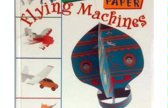

Science in the Museum – make your own spinning paper plane! Science in the Museum – make your own spinning paper plane!
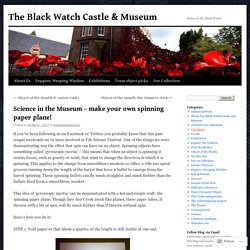
If you’ve been following us on Facebook or Twitter you probably know that this past couple weekends we’ve been involved in Fife Science Festival. One of the things we were demonstrating was the effect that spin can have on an object. Spinning objects have something called ‘gyroscopic inertia’ – this means that when an object is spinning it resists forces, such as gravity or wind, that want to change the direction in which it is spinning. This applies to the change from smoothbore muskets to rifles; a rifle has spiral grooves running down the length of the barrel that force a bullet to emerge from the barrel spinning. These spinning bullets can fly much straighter and much further than the bullets fired from a smoothbore musket.
David and Kayleen Design a Glider. Sid the Science Kid . Let's Fly! Flight Activities for Kids - Air Lesson Plans, Fun Teaching Ideas, Free Science Resources. Inquiry and Engineering: Gliders - Activity - www.teachengineering.org. Summary Student teams design, build and test small-sized gliders to maximize flight distance and an aerodynamic ratio, applying their knowledge of fluid dynamics to its role in flight.
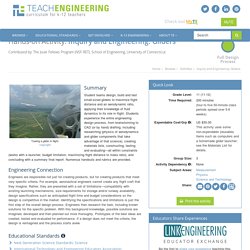
Students experience the entire engineering design process, from brainstorming to CAD (or by hand) drafting, including researching (physics of aerodynamics and glider components that take advantage of that science), creating materials lists, constructing, testing and evaluating—all within constraints (works with a launcher, budget limitation, maximizing flight distance to mass ratio), and concluding with a summary final report. Numerous handouts and rubrics are provided. Engineering Connection Engineers are responsible not just for creating products, but for creating products that meet very specific criteria. Educational Standards Each TeachEngineering lesson or activity is correlated to one or more K-12 science, technology, engineering or math (STEM) educational standards. Connecticut: Science Materials List. Flight Activities for Kids - Air Lesson Plans, Fun Teaching Ideas, Free Science Resources. Science Activity: Make a Mini-Helicopter From Paper! Make three Roto-Copters for each person.
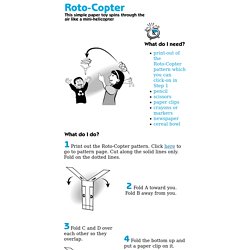
Use a marker to draw a 1-foot circle on a piece of newspaper. Put a cereal bowl in the middle of the circle. The circle is the target area and the bowl is the bull's-eye. Take turns standing on a chair at the edge of the newspaper and dropping your Roto-Copters. At the Exploratorium, we get 3 points for a bull's-eye, 2 points for a copter inside the circle, and one point for just hitting the newspaper-but you can make up any rules you want. Igor Sikorsky designed the first successful helicopter in the late 1930s. Igor I. Leonardo da Vinci Museum-This online gallery displays images and other information related to Leonardo da Vinci. This and dozens of other cool activities are included in the Exploratorium's Science Explorer books, available for purchase from our online store.
We would like to hear about your results and discoveries. . ©1997 Exploratorium. Design a Paper Airplane. Brief Description Students study examples of paper airplanes and then create their own paper airplane models.

Objectives. Science of Flight: Paper Airplanes. Paper airplanes are models of real (or imaginary) aircraft that are made from paper.

Some people call it aerogami, since it is somewhat similar to the traditional Japanese craft of folding paper. Paper Airplanes. Paper Airplane #2 (PA-2) & Paper Airplane #1 (PA-1) A glider is a special kind of aircraft that has no engine.
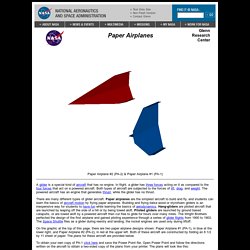
In flight, a glider has three forces acting on it as compared to the four forces that act on a powered aircraft. Both types of aircraft are subjected to the forces of lift, drag, and weight. The powered aircraft has an engine that generates thrust, while the glider has no thrust. There are many different types of glider aircraft. Science of Flight: Paper Airplanes. AMA Flight School. By John Anderson Project 3X5 is a unique approach to educational aerodynamics-using simple 3"X5" index cards to create interesting, good flying paper gliders.
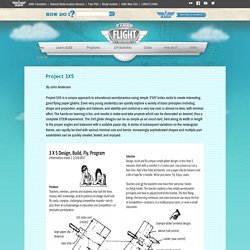
Even very young student(s) can quickly explore a variety of basic principles including: shape and proportion, angles and balance, and stability and control-at a very low cost, in almost no time, with minimal effort. The hands-on learning is fun, and results in make-and-take projects which can be decorated as desired, thus a complete STEM experience. The 3X5 glider designs can be as simple as an uncut card, bent along its width or length to the proper angles and balanced with a suitable paper clip. A series of subsequent variations on the rectangular theme, can rapidly be tried with various minimal cuts and bends. Download page 1 as PDF Download page 2 as PDF Download page 3 as PDF Watch an interview with the program's creator, John Anderson! For questions about the 3X5 Project, contact johnhanderson36@gmail.com. Science Activity: Make a Mini-Helicopter From Paper! Science Activity: Paper Airplane Made Of Hoops. Put one end of a straw onto the middle of a strip of tape.
Put the big hoop on top of the straw and fold the tape up the sides of the hoop. Now comes the fun! Hold the Hoopster in the middle of the straw, with the little hoop in front. Throw it like a spear. It may take a little practice, but once you get the hang of it, your Hoopster will really fly! This part can be a little tricky. If you want to experiment with Hoopsters, here are some other things you can try: